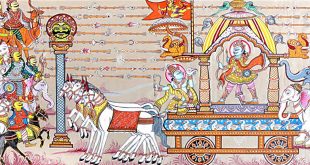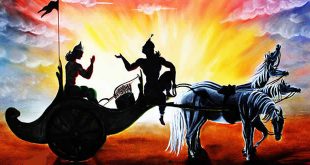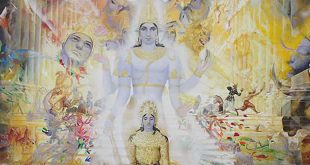Ksetra Ksetrajna Vibhaga Yoga-Bhagavad Gita Chapter 13 [The Individual and the Ultimate Consiousness]
Krishna Said > Shaloka: 6
![Ksetra Ksetrajna Vibhaga Yoga-Bhagavad Gita [Chapter: 13 - Verse 6]](https://www.4to40.com/wp-content/uploads/2015/01/13_shaloka_06.gif)
English
The five great elements, false ego, intelligence, the unmanifested, the ten senses, the mind, the five sense objects, desire, hatred, happiness, distress, the aggregate, the life symptoms, and convictions–all these are considered, in summary, to be the field of activities and its interactions.
Purport
From all the authoritative statements of the great sages, the Vedic hymns and the aphorisms of the Vedanta-sutra, the components of this world are earth, water, fire, air and ether. These are the five great elements (mahabhuta). Then there are false ego, intelligence and the unmanifested stage of the three modes of nature. Then there are five senses for acquiring knowledge: the eyes, ears, nose, tongue and touch. Then five working senses: voice, legs, hands, the anus and the genitals. Then, above the senses, there is the mind, which is within and which can be called the sense within. Therefore, including the mind, there are eleven senses altogether. Then there are the five objects of the senses: smell, taste, form, touch and sound. Now the aggregate of these twenty-four elements is called the field of activity. If one makes an analytical study of these twenty-four subjects, then he can very well understand the field of activity. Then there is desire, hatred, pleasure and pain, which are interactions, representations of the five great elements in the gross body. The living symptoms, represented by consciousness and conviction, are the manifestation of the subtle body–mind, ego and intelligence. These subtle elements are included within the field of activities.
The five great elements are a gross representation of the subtle false ego. They are a representation in the material conception. Consciousness is represented by intelligence, of which the unmanifested stage is the three modes of material nature. The unmanifested three modes of material nature is called pradhana.
One who desires to know the twenty-four elements in detail along with their interactions should study the philosophy in more detail. In Bhagavad-gita, a summary only is given.
The body is the representation of all these factors, and there are changes of the body, which are six in number: the body is born, it grows, it stays, it produces by-products, then begins to decay, and at the last stage it vanishes. Therefore the field is a nonpermanent material thing. However, the ksetrajna, the knower of the field, its proprietor, is different.
Hindi
![Ksetra Ksetrajna Vibhaga Yoga-Bhagavad Gita [Chapter: 13 - Verse 6]](https://www.4to40.com/wp-content/uploads/2015/01/13_shaloka_06_hindi.gif)
Punjabi
![Ksetra Ksetrajna Vibhaga Yoga-Bhagavad Gita [Chapter: 13 - Verse 6]](https://www.4to40.com/wp-content/uploads/2015/01/13_shaloka_06_punjabi.gif)
 Kids Portal For Parents India Kids Network
Kids Portal For Parents India Kids Network



